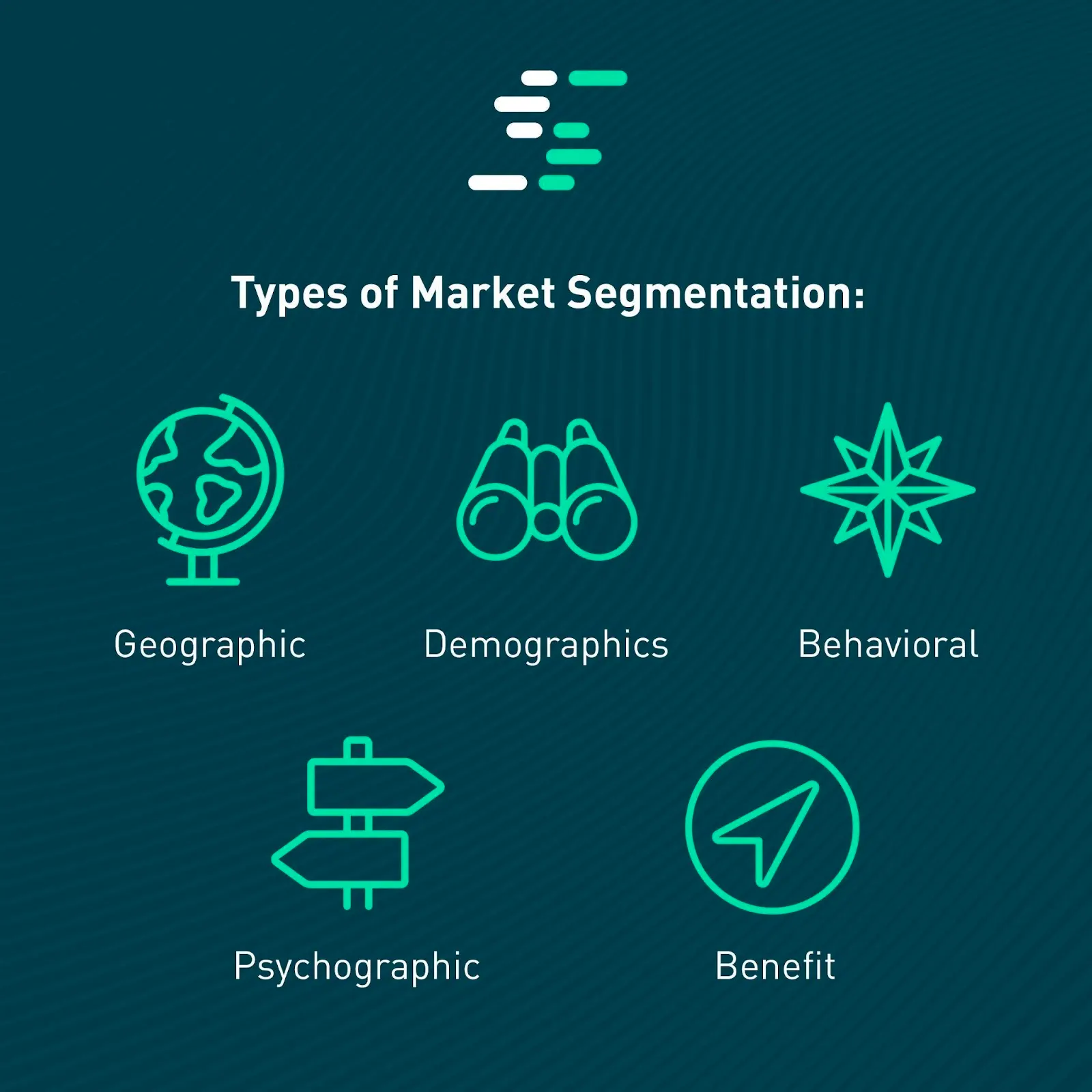Segmentation
Segmentation is still relevant, even in digital marketing.
While more and more specific tools are being created and used to target customers, old-fashioned segmentation is still relevant. Customers can be grouped based on demographics, geography, behavior, and other factors to form segments. These are groups of prospects or customers with similar behaviors and characteristics.
What makes these groups important is that their segmentation also determines how they perceive and use a product. These are groups with distinctive life experiences that are tied to the segment that you place them into. There are traditionally five segments that have to be used.
These range in benefit from the very obvious to much more complex measurements. Not every category of segmentation is an exact science. Some of it requires analysis and study of individual variables. Let’s go from the simplest to the most advanced form of segmentation and explain each one.


Geographic
The first traditional segment, and the simplest, refers to the location of customers. Those customers who are in a geographic area can all be placed together. This is helpful for businesses that do business in a specific area but can be misleading for other businesses.
It can be misleading because not everyone in the same area has the same experiences or acts in the same way. In the broadest sense, this can be true, but for companies that want a more targeted approach, this segmentation will fall short.
On the other hand, this does give a company an area to target. Geo-located advertisements are simple and easy to handle.

Demographic
This segment may be the most popular because it ticks many important boxes regarding information. Demographics refers to the age, gender, race, education, income, and employment of an individual. This can help to narrow down targets and considers if a specific demographic fits the profile of a standard customer, answering questions of whether they are interested and can use a product or service.
The government and many other organizations of different sizes and types use demographics. The weakness of this type of segmentation is that it assumes people with similar attributes will behave in the same way. The reality is far more complex, and it can’t take into account passions, hobbies, or other motivators.
For instance, a 36-year-old, uneducated factory worker who immigrated from Poland won’t have the same interests or proclivities as a 36-year-old factory worker who is US-born.

Behavioral
Accurate behavioral segmentation wasn’t always possible like it is today. A marketer can gather a lot more data regarding their customers’ behavior than they could before. This allows consumers to be grouped by behavioral patterns, such as buying patterns and even usage.
Another benefit to this is that it allows for targeted messaging. A message that is targeted based on behavioral traits is far more likely to make an impact on the desired consumer. As with all segmentations, however, there are a few drawbacks to consider.
The biggest drawback is that behavioral assessment is not a clear-cut science. There are a lot of gray areas where assumptions have to be made. One of those areas is lifestyle changes, such as becoming sick, divorced, or having a child. All of these things can change consumer behavior without appearing in the data for behavioral segmentation.

Benefit
Benefit segmentation reveals that one of the most important factors in marketing and business is perception. The benefit in this analysis refers to the perceived benefit that consumers feel the product or service gives them. Not only is this great information for marketing, but it can also be put to work for the business.
The benefit is often a value judgment that a consumer makes as soon as they see or look at a product or service. This cements the importance of making a great first impression.
Product development and research often center around what customers want or what will benefit them. Every company wants to know how its products are perceived and what it can do to make that perception better. How a customer perceives a product will impact how it is used and who purchases it.
In this case, a great analogy is clothing. A hoodie may appeal to a jogger, while a hiker may want a windbreaker or something more substantial. The regular person may want a jacket to wear from the car to home or work. Each person will perceive the value of your hoodie differently based on their needs.
Therefore, steps must be taken to ensure the hoodie being sold can reach more customers. Perhaps it should be marketed as lightweight and easy to take on and off. This would appeal to other groups and thus increase the segment that benefits from the product.

Psychographic
Don’t let the name intimidate you. It simply means lifestyle. This includes the activities, beliefs, opinions, and interests a consumer may have. Understanding these allows you to make a very targeted and specific marketing campaign online and offline.
There are some similarities between psychographic segmentation and behavioral segmentation. The difference is that psychographic segmentation accounts for changes in lifestyle that could impact behavior. Of course, like behavioral segmentation, it is not always easy to classify individuals with accuracy. To achieve any lasting success, a marketer must be able to use information from various sources and form reasoned conclusions from them.
The closer a marketer can get to having a true psychographic profile, the more effective their marketing strategies will be. The same rules apply. The more targeted and impactful a message or ad, the more likely it is to generate a new lead that will turn into a paying customer.
The Value of Segmentation
Segmentation doesn’t have to be just one type of category. Bringing together all the information required allows a marketer to build a persona. This persona attempts to accurately represent the perfect customer to target with specific ad campaigns and messaging.
The more segmentations used in developing this persona, the more accurate it will be. This increases the ROI for marketing.
Developing a perfect persona is as much about science as art. Consider all of the variables that can be assessed, and the persona created will be as accurate as possible. It is easy to overlook small details, but small details are vital when it comes to segmentation and persona crafting.
What Metrics Should I Be Measuring?
An effective marketing strategy monitors numerous metrics. This helps accurately measure the success of different campaigns to make informed, data-driven decisions.
Brand awareness is how familiar a target audience is with a brand.
When consumers feel connected to a brand, they’re more likely to be loyal to that brand. In essence, brand awareness efforts help humanize a company and give it a personality that people can relate to. Brand awareness is also important for the continued success of a business, as it helps build brand equity. A brand’s value is what’s known as brand equity.
When a brand is in high demand and has a positive perception from consumers, then a business can have the following:
- Higher prices on products because of a higher perceived value
- Larger social impact
- Higher stock price (if a public company)
Brand awareness is the building block to having brand equity.
Leads
Lead generation is the process of capturing a consumer’s interest in a product or service to move them through the sales funnel. Incorporating lead generation can help build brand awareness, generate qualified leads, and close deals.
It’s essential to monitor lead generation, so you know your marketing dollars are being put to good use. As data is gathered, you can gain deeper insights into the consumer journey.
Web Traffic
Increasing web traffic is a vital part of running any modern business. When there’s a steady flow of visitors to a company’s website – marketing funnels get prospects, and sales naturally grow.
Marketing analytics provides information to analyze. This analysis informs strategies for your site that will help it attract more people.
To track web traffic, monitor referrals, keywords, and most visited pages.
Brand Identity
Millions of businesses are out there, and almost every market is saturated, so companies need a strong brand identity to stand out. Brand identity consists of the following:
- What a brand says
- How it advertises its products
- Its values
- How people feel when they interact with the company
At its core, the personality of the business is the brand identity.
With a strong brand identity, a company can more easily attract new customers and retain those already on its books. Better brand identity boosts brand loyalty.
When marketing professionals monitor brand identity, they keep an eye on how people interact with and talk about the brand. This intel enables decision-makers to make changes and respond fast when needed.
Customer Retention
Customer retention has a sizable impact on profits – which is why loyalty is key. Note it usually costs less money to keep a customer than it does to find a new one. So, it’s crucial to know when it’s time to make a change to improve retention.
Some products, like laundry detergent, for example, have high levels of customer loyalty. Once a customer finds a product they like, they tend to stick with it. Brands like Apple and Nike have considerable levels of brand loyalty. Consumers seek out the brand regardless of the product they are considering.
On the other hand, there are other products with lower levels of brand loyalty. For instance, a customer might choose a brand of toilet paper that is on sale rather than a brand they feel loyal to. Price sensitivity and brand loyalty are in a never-ending tug-of-war.
Whatever category your product or services falls into, retention analysis can help improve customer retention. It is the process of analyzing user metrics to gain insight into how and why customers leave or opt for another brand.
By conducting retention analysis consistently, you can learn the following:
- Why customers churn
- When customers are likely to churn
- How to improve retention
The right KPIs need to be used in marketing analytics to understand retention. Some of the most common KPIs you might choose to track include:
- Customer churn rate
- Customer LTV
- Customer engagement score

Ready to Take Your Search Hustle Further?



